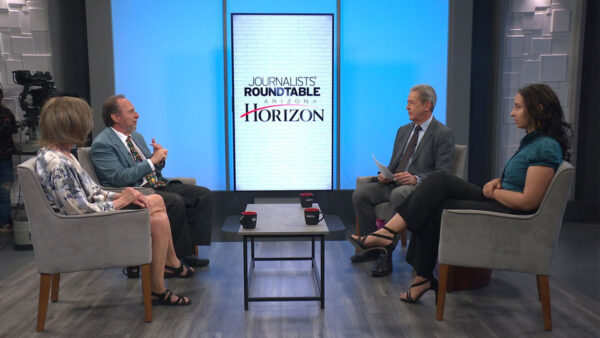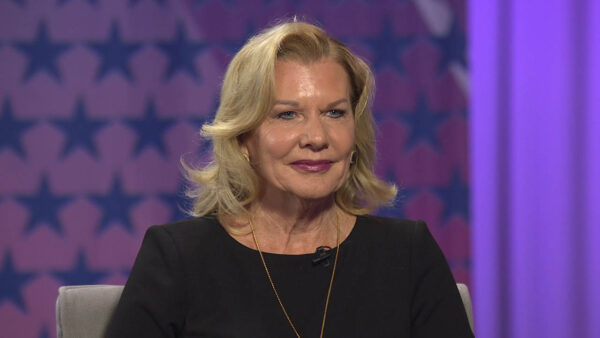The Arizona Independent Redistricting Commission has approved a draft map of new congressional district boundaries. Arizona Republic columnist Bob Robb, and political consultant Barry Dill provide analysis of the preliminary map.
Ted Simons: Starting tomorrow, the Arizona Independent Redistricting Commission is taking public comment on its draft political maps. Last week the Commission approved a draft congressional district map which brought much criticism, especially among Republicans. Here to provide analysis of the AIRC's preliminary congressional districts is "Arizona Republic" columnist Bob Robb, and Barry Dill, a political consultant with First Strategic, a Phoenix-based communications and public affairs firm.
Ted Simons: We'll take the 40,000-foot view and stay up there for the most part because we're talking about the entire state of Arizona. What are your thoughts?
Robert Robb: I think it's a very bad map and it does favor Democrats, but not as much as Republicans are complaining about. The district had to tilt the 10 status quo, either more towards the Republicans or more towards the Democrats, because we only got one additional congressional district. You couldn't maintain the status quo. They have preserved in my judgment the same number of competitive districts, the same number of safe Republican districts and the same number of safe Democratic districts. What they did, they took the same number of competitive districts and made it a strongly-leaning Democratic district. Basically with the new district, they made it strongly leaning Democratic, but it had to be one way or the other. The real problem is the way they did that. The communities of interest they run rough-shod over by picking up a large swath of Pinal County and throwing it into the western district, when it more naturally is a fit with the eastern district; and then creating a competitive district that divides the suburban cities of Scottsdale, Chandler and Mesa, which wasn't necessary.
Ted Simons: Thoughts?
Barry Dill: Well, first of all, I think that the commission has a really tough job, based upon the demographics of the state. And I think this commission; its major focus is on competitiveness. Whereas the commission 10 years ago was more on compactness and cultural boundaries and all that sort of thing. What I find amusing about the entire debate is what I told you a couple weeks ago. 11 The Republican talking points about why they dislike this particular commission and this map are exactly the ones that my party used 10 years ago with a more sort of Republican-leaning commission.
Ted Simons: You mentioned an emphasis on competitive districts. Republicans are saying there's too much of an emphasis on competition. Valid?
Robert Robb: Well, I reject the premise. I don't think you can explain this map by a primacy given to Republicans. Flagstaff is a Democratically-leaning area. It could have naturally fit demographically with the western rural district or the eastern rural district. It was placed in the eastern rural district. That required this odd skirting around the top of Maricopa County and going far east to pick up parts of Pinal County.
Ted Simons: And you're speaking of District 4, correct?
Robert Robb: District 4. It requires District 4 to pick up population in Pinal county, which doesn't naturally fit. If Flagstaff had been put in the western district 4 rather than eastern district 1, it would have made both 4 and 1 more competitive. The western district would be less Republican, the eastern district would be less Democratic.
Barry Dill: Let me tell you one premise that Bob's making I do not believe is true, is that the new district is -- even though by voter registration it would appear to have grown more 12 Democratic, but it does not take into account the traditional challenges that Navajo voters are actually going to the polls to vote, which include inclement weather, the fact that the federal elections and the tribal elections are not held either on the same day nor in the same locations, and it also does not take into account information we know that the biggest Navajo voters right now are young Navajos. They tend to be spread out in Tempe going to college, or at Tucson or Palo Alto or someplace else. By an actual turnout percentage, it's really not all that much Democratic and I would suggest is a swing district.
Robert Robb: Well, in 2010, which was a tidal wave election for Republicans-
Barry Dill: Absolutely.
Robert Robb: -- defeated Kirkpatrick by 6 percentage points. The map is potential competitive only in a tidal wave Republican election. Year in, year out, it's going to be a relatively safe Democratic district, if the Democrats field a --
Barry Dill: There's another interesting saga to the Flagstaff saga. We do know that originally both sides were talking about splitting Flagstaff in half, and having the east Flagstaff in the east district and west Flagstaff in the west district, thereby having two Representatives in essence. The City of Flagstaff is the one who turned that down.
Ted Simons: Bob, I now Democrats are saying how can Republicans say this favored Democrats, when they are -- I know you debate the competitive aspect of this -- the way Democrats see it, there are four strong Republican districts, two strong mostly voter rights districts favoring Democrats and they see three competitive. They would love to see four competitive districts because they think it makes it even closer.
Robert Robb: The voting rights act pretty much precludes three truly competitive districts. You just don't have enough Democratic population to create three competitive districts. I do believe the protest over the political map is overstated. You're currently four Republican, two Democrat, two competitive districts, you now will be four Republican, two Democrat, two competitive and one strongly leaning Democrat in my view. It had to be either leaning Democrat or leaning Republican. The problem with the map isn't its political results, it's the way it achieves them by running rough shod over natural political boundary.
Barry Dill: Democrats don't necessarily like what they got conclusion confuses the whole issue about why the Republicans are so upset. Democrats we know in asking for and wanting four competitive districts. They also wanted only one border district instead of what they have produced now. They have three. So Democrats aren't getting everything they wanted either, which suggests to me that if everyone's upset, it's probably 14 okay.
Ted Simons: The idea of communities of interest and geographic boundaries being pretty much run rough-shod, as opposed to competition or other aspects of the map, or even things that aren't constitutionally required to be an aspect of the map, do they get short sh rift here?
Barry Dill: Again, as I said earlier, to the subject of competitiveness as a primary concern over some of those other things, you know, you could make that case. The district is a big, sprawling -- it goes from the Mexican border, the New Mexico can border all the way to Utah and then to the mouth of Grand Canyon.
Ted Simons: Looking at it in blue, it's bigger than half the states in America.
Barry Dill: It is gargantuan. Less Republicans and Democrats fill the voter registration rolls because of independents. The demographics of the state are changing. So the challenge to make things as competitive as possible is great.
Ted Simons: Will the map change? Should the map change?
Robert Robb: I definitely think the map should change. Whether it will change I think by -- voluntarily by the commission will depend upon the amount of political leaders of these areas that are sort of thrown in with unlikely company, and the extent to which they show up at these hearings and how vigorously they protest their treatment under this map.
Barry Dill: My view that it's Republicans are trying to bully or at least 15 urge a big turnout, make a lot of noise, in order to try to force the commission to make changes. I quit learning to make predictions after the O.J. trial. I have no idea whether they will change or not.
Ted Simons: Thank you both, it's an interesting map with curiosities to it, but I guess that goes with the territory. Thanks for joining us.
Robert Robb: Thank you.
>>> The Independent Redistricting Commission is holding 26 meetings across the state for the public to comment on its draft maps for congressional and legislative districts. The first is tomorrow evening at the Phoenix College Auditorium. For more information go online to azredistricting.org.
Bob Robb:Arizona Republic columnist,Barry Dill:Political Consultant




















